All Good Things Come to An End …
Two years have gone by very quickly and here we are at the end of the project. It has been an incredible journey, dotted with some disappointments but successful overall.
The main challenge of the project proved to be collagen extraction from human remains. Due to its degradation in bone, our attempts to extract it failed in a number of samples, greatly affecting our chances of obtaining C14 dates and carbon and nitrogen stable isotope data from the skeletons. In cases of successful collagen extraction, the quantity obtained from the samples was barely enough for isotope analysis but in the end proved insufficient to yield results.
We have been very successful with obtaining carbon and oxygen data from bioapatite, which was also used for radiocarbon dating of selected skeletal remains. Human remains, animal and botanical samples also yielded strontium data. Isotopic data is now being studied in preparation for publication. We are really excited that the data demonstrates statistically significant changes during the Late and Post-Meroitic Period!
The list of the sites included in the project and type of samples collected are presented in the Data Table. I would like to take this opportunity to once again thank the team and our collaborators for their great work and enthusiastic support throughout the duration of the project. This phase of the project has yielded incredibly promising results and raised important questions which merit further investigation. We shall continue …
If you are interested in this research and collaboration, please get in touch.
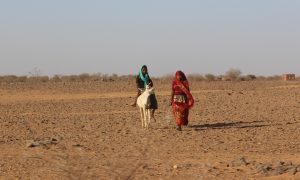
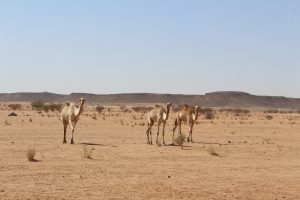
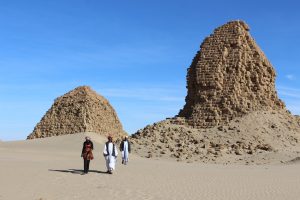
University of Central Florida, Orlando, USA (February 2019)
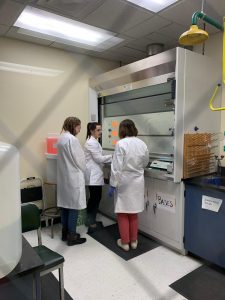
Preparing samples under Tosha’s watchful eye
Following a couple of unsuccessful attempts of collagen extraction from bone tissue, Iwona headed west across the Atlantic to the University of Central Florida, USA, to work on a selection of samples with Dr. Tosha Dupras and her students. The team followed the Bioarchaeological Sciences Lab protocol and established methods for collagen and apatite extraction. This time we successfully isolated collagen from two-thirds of the samples and now will have to wait (very impatiently!) to see if it is usable for the next step. This is already a very exciting development, since so many samples previously failed the standard collagen extraction protocol, and many of the colleagues working in Sudan have reported very poor results, believed to be due to the poor bone condition and collagen preservation.
I couldn’t have been more pleased with the results so far and would like to say a massive thank-you to my colleague, Tosha and her absolutely wonderful masters students, Lexie and Rachel. Thank you, Ladies, for a great time in the lab and I wish you all the best with your research projects! Hope to see you in Sudan, Tosha!
National Corporation for Antiquities and Museums, Khartoum, Sudan (February 2019)
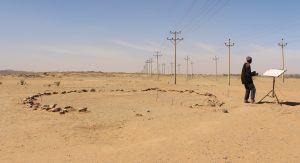
Field documentation at the cemetery, Ously East
Iwona’s final project visit to Sudan was short but very work-intensive. Her main aim was to examine skeletal remains from a Post-Meroitic cemetery at Ousli East (DS 231), excavated by the Sudanese archaeologists in early 2018. Despite tomb looting that took place most likely in antiquity, the skeletons proved to be largely complete and very well preserved, and demonstrated evidence of interesting pathological conditions.
The visit provided the opportunity to further discuss future works in collaboration with NCAM, focused on human remains from and beyond the Meroitic and Post-Meroitic Period. It was a great pleasure to have worked with the Sudanese colleagues and I look forward to continuing our collaboration.
Once again, I would like to thank Dr Abdelrahman Ali Mohamed, director general of NCAM, and my colleague, Abdelhay Abdelsawy, and fellow inspectors for their support and assistance onsite and in the field during my research visits.
One last thing that Iwona had planned for her February visit in Sudan was to give a talk about the project to the University of Khartoum students of archaeology. Unfortunately, due to the unforeseen circumstances, the University remained closed for the duration of Iwona’s stay in Khartoum. But there is always a next time …
PAP Nauka w Polsce / Science in Poland – Interview
Shortly before leaving for Sudan, Iwona gave an interview for the PAP Nauka w Polsce/Science in Poland. The result of this interview was an online short article (in Polish) for general public on Iwona’s research in Sudan.
Joint Conference on the Bioarchaeology of Ancient Egypt & the International Symposium on Animals in Ancient Egypt, American University in Cairo, 10th – 13th January 2019
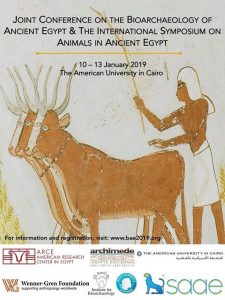
For the third time, the American University in Cairo was the host of the Bioarchaeology of Ancient Egypt conference, offering scholars representing disciplines such as archaeology of Egypt and Sudan, archaeozoology, physical anthropology, and archaeobotany a great opportunity to present and discuss their research in the hopes of future integrated collaboration.
Iwona presented the preliminary results of the carbon and oxygen stable isotope analysis of human remains from selected archaeological sites, as well as a rare case of a birth-related trauma in an infant skeleton from a Late Meroitic cemetery at Korti.
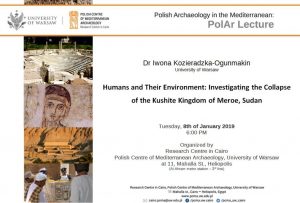 While in Cairo, Iwona also gave a public lecture on Humans and Their Environment: Investigating the Collapse of the Kushite Kingdom of Meroe, Sudan at the Polish Centre of Mediterranean Archaeology.
While in Cairo, Iwona also gave a public lecture on Humans and Their Environment: Investigating the Collapse of the Kushite Kingdom of Meroe, Sudan at the Polish Centre of Mediterranean Archaeology.
Approaching the end of the project ….
With just a few more months left to go, it was important to review the results obtained so far and prepare the sample inventory for the final round of the stable isotope analyses (δ13C, δ18O and δ87Sr/86Sr) and radiocarbon dating. Additional samples of animal remains and modern plants from various locations in the Nile Valley were submitted for strontium analysis. A small selection of samples of human remains from the cemetery sites at Jebel Moya, Meroe, Zuma, Ousli and Tanqasi were sent to the GADAM Centre (Gliwice Absolute Dating Methods Centre) for radiocarbon dating.
Now all we can do is to remain hopeful and wait for the final results (fingers crossed)!
Results of strontium, oxygen and carbon stable isotope analyses are in!
Earlier this year, a total of 66 human and botanical samples from 11 archaeological sites were submitted for strontium (δ87Sr/86Sr) stable isotope analysis, and the results are finally in! The analysis was conducted at the AMU Isotope Laboratory in Poznan, Poland.
In August, additional 17 samples (human and animal) were also submitted for oxygen (δ18O) and carbon (δ13C) isotope analysis. The analysis was conducted at the Stable Isotope Laboratory at CAGE (Centre for Arctic Gas Hydrate, Environment and Climate), Arctic University of Norway.
14th International Conference for Nubian Studies, Musée du Louvre and Sorbonne University, Paris, 10th – 15th September 2018
 The 14th International Conference for Nubian Studies, held in Paris, brought together archaeologists and other scholars working in Nubia, Egypt and Sudan. This week-long event presented a perfect opportunity to learn about the current state of research in the region, from prehistory to modern times. During the conference, Iwona presented the preliminary results of stable isotope analysis of human remains from selected archaeological sites.
The 14th International Conference for Nubian Studies, held in Paris, brought together archaeologists and other scholars working in Nubia, Egypt and Sudan. This week-long event presented a perfect opportunity to learn about the current state of research in the region, from prehistory to modern times. During the conference, Iwona presented the preliminary results of stable isotope analysis of human remains from selected archaeological sites.
First results of oxygen and carbon stable isotope analysis
Earlier this year, a total of 25 dental enamel samples were submitted for oxygen (δ18O) and carbon (δ13C) isotope analysis. The samples were collected from third molars of the skeletons recovered from the following sites: Mansourkotti (2), Korti (6) Ously (2), el-Zuma (6), el-Detti (2), el-Kurru (1), Tanqasi (1), Hamadab (3), Meroe (1), and Jebel Moya (1). These preliminary results of the project will be presented at the 14th International Conference for Nubian Studies, held in Paris between 10th–15th September 2018.
The analysis was conducted at the Stable Isotope Laboratory at CAGE (Centre for Arctic Gas Hydrate, Environment and Climate), Arctic University of Norway.
The results of 14C are in!
We are very excited about the results of radiocarbon dating analysis conducted on samples from 10 archaeological sites. Out of 18 samples submitted, 12 proved viable and produced much anticipated results. The Meroitic and/or Post-Meroitic dates have been confirmed for the specimens from the following sites: Tabo, Mansourkotti, Korti, Zuma and Detti. We have also had a few outliers, which produced dates much earlier or later than expected. Sadly, the samples from Hamadab, Ousli and Jebel Moya were not sufficiently rich in collagen to yield any results.
The analysis was conducted at the Poznan Radiocarbon Laboratory in Poland.
Natural History Museum, Vienna, June 2018
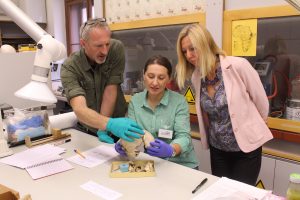
Iwona with Sabine and Bernhard in the NHM lab
In June, Iwona visited the Natural History Museum in Vienna to assess the potential of the skeletal remains from Toshka and Arminna for comparative studies. The sites were excavated at the time of the Archaeological Survey of Nubia in 1911 and 1912 by Hermann Junker and his team. A permission has been granted for limited sampling to conduct stable isotope analysis and radiocarbon dating on selected specimens.
My thanks go to Prof. Sabine Eggers, Dr Karin Wiltschke-Schrotta, Bernhard Weinzinger and other staff members at the Anthropology Department for a very warm welcome and assistance throughout my short visit.
Annual ‘Poles on the Nile’ Conference, University of Warsaw, 11th – 13th June 2018
Iwona presented an update on the project at the annual archaeological conference entitled ‘Poles on the Nile’ (Polacy and Nilem), organised jointly by the Department of Archaeology of Egypt and Nubia, and the Polish Centre of Mediterranean Archaeology, University of Warsaw.
Progress update on sample processing and analysis
Over the past few months, we were able to collect bone and dental samples from just over 80 individuals from 12 different archaeological sites in Sudan. We would like to thank museum curators, project and field directors for their support and assistance, and patience in waiting for updates on the samples.
Processing of the samples is now well underway with the assistance of our new team member, Joanna Szymczak. The samples have been inventoried and divided into several groups for stable isotope analysis (Sr, C, O and N) and radiocarbon dating. We expect to have some preliminary results by the end of June, so please check for updates.
In addition to the above development, we have also established a new collaboration with Dr Laura Weyrich, University of Adelaide, who has agreed to add our dental calculus samples to her research project, which aims to reconstruct oral microbial communities from ancient humans on six continents over the past 20,000 years. You can learn more about Laura’s research here.
Sudan, January – February 2018
This time, Iwona focused on visiting selected archaeological sites, located to the north of the capital city of Khartoum, with the aim to study and sample skeletal remains from recently excavated Meroitic and Post-Meroitic cemeteries.
The first sites visited were El-Zuma, El-Detti and Tanqasi excavated by a joint team from the Polish Centre of Mediterranean Archaeology (PCMA), University of Warsaw, and the National Corporation for Antiquities and Museum of Sudan (NCAM). The first two sites are in a short distance downstream from the royal necropolis at El-Kurru, on the right bank of the Nile, with Tanqasi located on the opposite side of the river. Long bone and dental samples were collected from a total of 33 individuals, predominantly from El-Zuma.
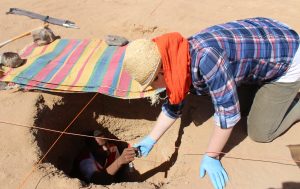
Mohamed and Iwona during hands-on training in recovery of skeletal elements from one of the graves at Ously
The next stop was a cemetery site at Ousli, situated some 25km downstream from Tanqasi. The site was identified during the Dabba Dam Archaeological Survey Project (DDASP) carried out by the NCAM team, with several tumuli excavated in February 2018. Bone and dental samples were collected from a total of four individuals. The site visit was a perfect opportunity for Iwona to deliver hands-on training in recovery and inventory of human remains to the team of local archaeologists.
From Ousli, Iwona travelled south-east to the heartland of the Meroitic Kingdom. Located just 3km south of the ancient capital of Meroe, on the east bank of the Nile lies an urban town of Hamadab. The excavations of the settlement and its nearby cemetery are led by a team from the German Archaeological Institute (DAI). At the time of Iwona’s visit, the remains of 13 individuals recovered from Hamadab and one from Meroe were available for examination and sampling.
Back in Khartoum, Iwona’s final task was to study and sample skeletal remains recently excavated at Jebel Moya, as part of a multidisciplinary project led by a joint team from the University College London and University of Khartoum.
A huge thank-you to Dr Abdelrahman Ali Mohamed, director general of NCAM, and project and field directors, Dr hab. Mahmoud El-Tayeb (PCMA), Abdelhay Alsawy (NCAM), Dr Pawel Wolf (DAI), Dr Michael Brass (UCL) and Dr Ahmed Hussein Abdelrahman Adam (University of Khartoum), for their support and assistance during my stay in Sudan, and to the archaeological teams for their very warm welcome. A special thank-you to Magda Srienc (PCMA team) for her fantastic work and assistance with sampling.
Information on archaeological sites and projects can be found here.
The Boston Museum of Fine Arts and the Peabody Museum of Archaeology and Ethnology, University of Harvard, Cambridge, Massachusetts (October 2017)
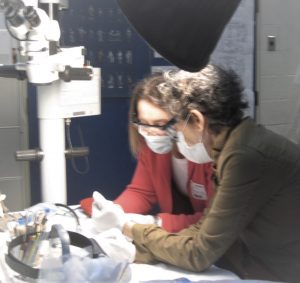
Iwona sampling at MFA
Following a very successful research visit to Sudan, Iwona travelled to Boston, USA, to study skeletal remains from el-Kurru, one of the royal cemeteries during the Napatan period. The human remains were brought to the USA by George Reisner, the director of the joint Harvard-Boston archaeological expedition, and divided between the two institutions. The Peabody Museum holds the larger assemblage of the skeletal remains, which date from the Napatan to Christian period. The remains of 24 individuals were macroscopically studied by Iwona and assessed for potential sampling. A total of seven teeth from the Museum of Fine Arts collection were sampled for enamel and dentine.
I would like to thank Denise Doxey (MFA), Michèle Morgan and Sarah Schoff (Peabody Museum) for granting access to the respective skeletal collections and for their invaluable assistance during my research visit.
National Corporation for Antiquities and Museums, Khartoum, Sudan (September – October 2017)
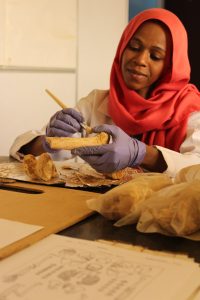
Remah assisting with cleaning and bone inventory at NCAM, Khartoum
In late September, Iwona travelled to Sudan to study and sample skeletal remains held at the National Corporation for Antiquities and Museums (NCAM) in Khartoum. Thanks to the support and assistance kindly provided by Dr Abdelrahman Ali Mohamed, director general of NCAM, al-Hassan Ahmed Mohamed, senior antiquities inspector, and Abdelhai Abdelsawy, field director, Iwona was granted access to a small skeletal assemblage from the ongoing Dabba Dam Archaeological Survey Project (DDASP). Over the course of two weeks, a total of 12 skeletons from Mansourkotti (DS2) and Korti (DS128) were examined macroscopically for evidence of selected dental and skeletal health indicators, and nearly 60 dental and bone samples were collected for stable isotope analysis. A small selection of samples will also be submitted for radiocarbon dating. This includes samples collected from skeletal remains recovered from a probable Meroitic cemetery at Er-Roseires in the Blue Nile state, which we are particularly excited about.
During Iwona’s visit at NCAM, the staff and graduate trainees had an opportunity to refresh their knowledge of human osteology and have hands-on experience in inventory and examination of skeletal remains ahead of the upcoming field season. A big thank-you to Remah for helping with cleaning and bone inventory.
The visit at NCAM was completed with a couple of chance meetings with colleagues currently working at Wadi Abu Dom (Universität Münster, Germany) and Jebel Moya (University College London, UK), the sites of great interest to the project, with some exciting talks about opportunities for collaborative work.
This two-week visit in Khartoum was incredibly work-intensive and thanks are due to all NCAM staff for their support and assistance, and a very warm welcome.
Département de Génétique & Evolution, Unite d’Anthropologie, Université de Genéve Switzerland (August 2017)
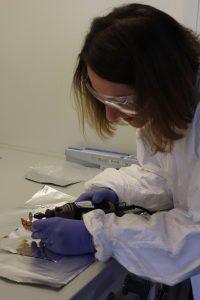
Iwona sampling at UA, University of Geneva
At the end of August, Iwona visited the Anthropology Unit at the Department of Genetics and Evolution, University of Geneva. The purpose of the visit was to sample and visually examine human remains recovered from a Meroitic cemetery in Tabo, Sudan, excavated in early 1970s by the University’s archaeological team directed by Charles Bonnet. Samples of dental enamel and dentine, and long bone for stable isotope analysis were collected from a total of 13 individuals.
I would like to thank Anne Mayor and Eric Huysecom for granting access to the skeletal collection, Nonhlanhla Dlamini-Stoll for her invaluable assistance, and everybody at the Anthropology Unit for their warm welcome and help during my visit.
The British Museum, London, UK (June 2017)
Iwona spent a couple of weeks at the British Museum, studying a skeletal collection from Gabati, a multiperiod cemetery, discovered in 1993. Just shy of 200 individuals, the Gabati assemblage includes skeletal remains from Meroitic, Post-Meroitic and Medieval cemeteries. A big thank-you to Daniel Antoine, the curator of physical anthropology at BM, for granting access to the collection, which I hope to revisit soon to collect more data.
24th National Nubiological Conference, 2nd – 4th June 2017 Gdańsk, Poland
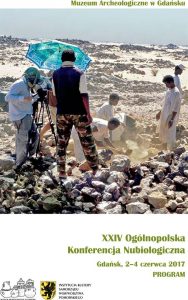 Iwona attended the 24th National Nubiological Conference in Gdańsk, organised by a fantastic team from the National Archaeological Museum in Gdańsk. The meeting was very well attended by archaeologists and specialists representing various academic disciplines, who participate in research projects in Sudan, and thus presented a great opportunity for networking. Iwona gave a presentation on the new project, extending an invitation to collaborate to colleagues working on Meroitic and Post-Meroitic cemeteries.
Iwona attended the 24th National Nubiological Conference in Gdańsk, organised by a fantastic team from the National Archaeological Museum in Gdańsk. The meeting was very well attended by archaeologists and specialists representing various academic disciplines, who participate in research projects in Sudan, and thus presented a great opportunity for networking. Iwona gave a presentation on the new project, extending an invitation to collaborate to colleagues working on Meroitic and Post-Meroitic cemeteries.
